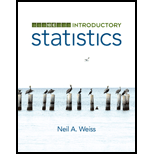
Concept explainers
Exercises 7.11–7.23 are intended solely to provide concrete illustrations of the sampling distribution of the sample
7.20 America’s Richest. Repeat parts (b)–(e) of Exercise 7.17 for samples of size 4. (There are 15 possible samples.)
7.17 America’s Richest. Each year, Forbes magazine publishes a list of the richest people in the United States. As of September 16, 2013, the six richest Americans and their wealth (to the nearest billion dollars) are as shown in the following table. Consider these six people a population of interest.
| Person | Wealth ($ billions) |
| Bill Gates (G) | 72 |
| Warren Buffett (B) | 59 |
| Larry Ellison (E) | 41 |
| Charles Koch (C) | 36 |
| David Koch (D) | 36 |
| Christy Walton (W) | 35 |
- a. Calculate the mean wealth, μ, of the six people.
- b. For samples of size 2, construct a table similar to Table 7.2 on page 310. (There are 15 possible samples of size 2.)
- c. Draw a dotplot for the sampling distribution of the sample mean for samples of size 2.
- d. For a random
sample of size 2, what is the chance that the sample mean will equal the population mean?
For a random sample of size 2, determine the
Want to see the full answer?
Check out a sample textbook solution
Chapter 7 Solutions
Introductory Statistics (10th Edition)
Additional Math Textbook Solutions
APPLIED STAT.IN BUS.+ECONOMICS
College Algebra (Collegiate Math)
Elementary and Intermediate Algebra: Concepts and Applications (7th Edition)
Elementary Statistics ( 3rd International Edition ) Isbn:9781260092561
Graphical Approach To College Algebra
Elementary Statistics: Picturing the World (7th Edition)
- A marketing agency wants to determine whether different advertising platforms generate significantly different levels of customer engagement. The agency measures the average number of daily clicks on ads for three platforms: Social Media, Search Engines, and Email Campaigns. The agency collects data on daily clicks for each platform over a 10-day period and wants to test whether there is a statistically significant difference in the mean number of daily clicks among these platforms. Conduct ANOVA test. You can provide your answer by inserting a text box and the answer must include: also please provide a step by on getting the answers in excel Null hypothesis, Alternative hypothesis, Show answer (output table/summary table), and Conclusion based on the P value.arrow_forwardA company found that the daily sales revenue of its flagship product follows a normal distribution with a mean of $4500 and a standard deviation of $450. The company defines a "high-sales day" that is, any day with sales exceeding $4800. please provide a step by step on how to get the answers Q: What percentage of days can the company expect to have "high-sales days" or sales greater than $4800? Q: What is the sales revenue threshold for the bottom 10% of days? (please note that 10% refers to the probability/area under bell curve towards the lower tail of bell curve) Provide answers in the yellow cellsarrow_forwardBusiness Discussarrow_forward
- The following data represent total ventilation measured in liters of air per minute per square meter of body area for two independent (and randomly chosen) samples. Analyze these data using the appropriate non-parametric hypothesis testarrow_forwardeach column represents before & after measurements on the same individual. Analyze with the appropriate non-parametric hypothesis test for a paired design.arrow_forwardShould you be confident in applying your regression equation to estimate the heart rate of a python at 35°C? Why or why not?arrow_forward
 Glencoe Algebra 1, Student Edition, 9780079039897...AlgebraISBN:9780079039897Author:CarterPublisher:McGraw Hill
Glencoe Algebra 1, Student Edition, 9780079039897...AlgebraISBN:9780079039897Author:CarterPublisher:McGraw Hill Holt Mcdougal Larson Pre-algebra: Student Edition...AlgebraISBN:9780547587776Author:HOLT MCDOUGALPublisher:HOLT MCDOUGAL
Holt Mcdougal Larson Pre-algebra: Student Edition...AlgebraISBN:9780547587776Author:HOLT MCDOUGALPublisher:HOLT MCDOUGAL

